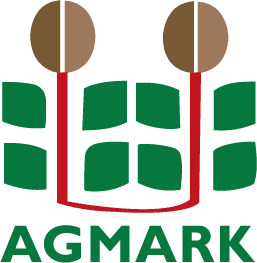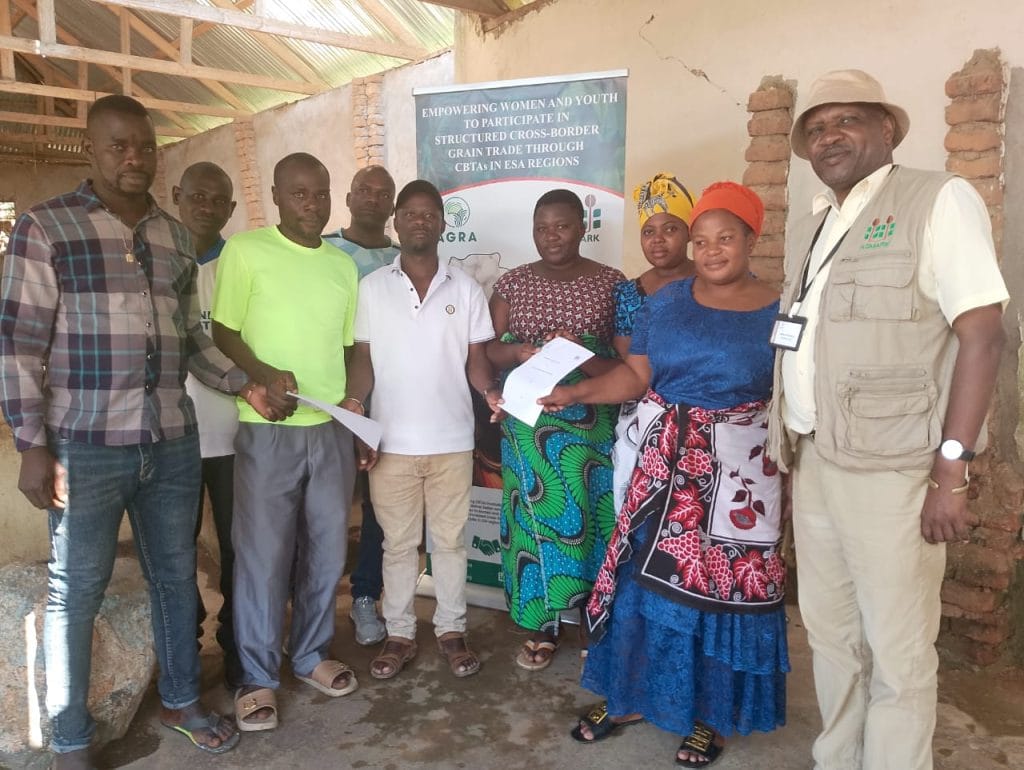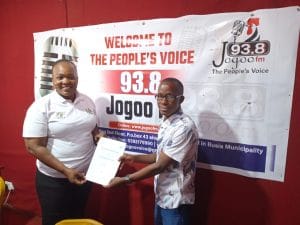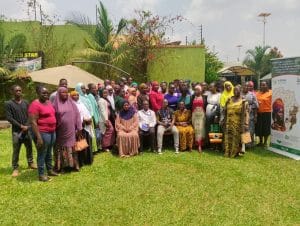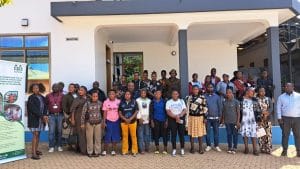A new chapter in cross-border grain trade has begun at the Songwe-Kasumulu border, and it’s being written by the hands of women and youth traders who are ready to transform informal hustle into structured, sustainable business.
AGMARK, in partnership with AGRA, continues to expand its mission of empowering women and youth across East and Southern Africa through the Cross Border Trade Association (CBTA) initiative. This time, the spotlight is on Songwe, Malawi, and Kasumulu, Tanzania. This is a critical trade corridor that’s now home to a newly formed, women and youth-led CBTA.
Between July 23 and August 6, 2025, AGMARK conducted intensive mobilization, leadership training, and institutional setup activities that resulted in the official establishment of the Songwe Cross Border Trade Association. This is a true game-changer for traders who have long operated in the shadows of informal trade.
Also Read: Youth Trade Focus at the Malawi-Tanzania Border
AGMARK, in partnership with AGRA, continues to expand its mission of empowering women and youth across East and Southern Africa through the Cross Border Trade Association (CBTA) initiative. This time, the spotlight is on Songwe, Malawi, and Kasumulu, Tanzania. This is a critical trade corridor that’s now home to a newly formed, women and youth-led CBTA.
Between July 23 and August 6, 2025, AGMARK conducted intensive mobilization, leadership training, and institutional setup activities that resulted in the official establishment of the Songwe Cross Border Trade Association. This is a true game-changer for traders who have long operated in the shadows of informal trade.
Also Read: Youth Trade Focus at the Malawi-Tanzania Border
Mobilization of Youth and Women Traders in Songwe
Building on relationships established during an institutional assessment in November 2024, AGMARK worked closely with border officials and local Malawi administration to identify and mobilize traders who could form the backbone of this new association.
But this wasn’t about bringing just anyone to the table. AGMARK set clear eligibility criteria designed to center the voices that matter most. The focus was on:
The result? A diverse, energetic group of traders and the boots-on-the-ground operators who keep cross-border trade moving every single day, eager to transition from survival mode to strategic growth.
But this wasn’t about bringing just anyone to the table. AGMARK set clear eligibility criteria designed to center the voices that matter most. The focus was on:
- Women and youth actively engaged in grain trade at the border.
- Individuals working in trader shops
- Those drying and transporting grain
- Workers within storage facilities
The result? A diverse, energetic group of traders and the boots-on-the-ground operators who keep cross-border trade moving every single day, eager to transition from survival mode to strategic growth.
Building Governance Skills for Women and Youth Traders
Ten interim leaders—both women and youth—were selected to guide the newly formed CBTA. These weren’t just ceremonial appointments. AGMARK delivered a comprehensive one-day Leadership and Governance training that equipped them with the tools to lead with confidence, accountability, and vision.
The training covered essential skills for running a trade association, from organizational governance to member engagement and advocacy. Daily registration and end-of-training evaluations ensured that every participant’s voice was heard and that the learning was grounded in real-world application.
Importantly, local administration and Malawi Revenue Authority officials were invited to participate, creating alignment between the new CBTA leadership and the government structures they would need to work alongside. This was important to build and maintain legitimacy and trust within the broader trade ecosystem.
The training covered essential skills for running a trade association, from organizational governance to member engagement and advocacy. Daily registration and end-of-training evaluations ensured that every participant’s voice was heard and that the learning was grounded in real-world application.
Importantly, local administration and Malawi Revenue Authority officials were invited to participate, creating alignment between the new CBTA leadership and the government structures they would need to work alongside. This was important to build and maintain legitimacy and trust within the broader trade ecosystem.
Malawi Revenue Authority Recognizes New Cross Border Trade Association
Ms. Christine Mukanadawire, Deputy Officer in Charge at the Malawi Revenue Authority, officially recognized the interim CBTA leadership and committed to working alongside them. In a powerful move, the CBTA was integrated into the Joint Border Committee (JBC)—a coordination body that brings together government officials and private sector players.
This is huge. It means that women and youth traders now have a seat at the table where trade policies and border operations are discussed and shaped. Local administration representative GUH Mwandenga also recognized the CBTA and pledged to fast-track government registration—a critical step toward full legal standing and long-term sustainability.
This is huge. It means that women and youth traders now have a seat at the table where trade policies and border operations are discussed and shaped. Local administration representative GUH Mwandenga also recognized the CBTA and pledged to fast-track government registration—a critical step toward full legal standing and long-term sustainability.
Overcoming Cross Border Trade Challenges at Songwe-Kasumulu Border
Launching a cross-border trade association in a remote border region isn’t without its hurdles. Poor network coverage made internet access and communication unreliable. Security concerns when using public transport in Tanzania also required extra vigilance.
Perhaps the biggest challenge? The lack of accurate, up-to-date information on cross-border traders’ associations in the region. AGMARK was essentially building in the dark, creating something new where little documentation existed.
And then there’s the reality of working with independent traders who’ve spent years operating solo. Convening them, aligning their interests, and convincing them to think collectively required patience, persistence, and trust-building. But once interim officials were in place, momentum followed.
Perhaps the biggest challenge? The lack of accurate, up-to-date information on cross-border traders’ associations in the region. AGMARK was essentially building in the dark, creating something new where little documentation existed.
And then there’s the reality of working with independent traders who’ve spent years operating solo. Convening them, aligning their interests, and convincing them to think collectively required patience, persistence, and trust-building. But once interim officials were in place, momentum followed.
Future Plans for Youth-Led Grain Trade in East Africa
AGMARK isn’t walking away after the ink dries. We will work closely with the Songwe CBTA to bring it up to par with other associations across the region, support government efforts to fast-track registration, and monitor the CBTA’s integration into Joint Border Coordination Committees.
This is about building a sustainable pipeline of women and youth-led trade infrastructure, one border at a time. Songwe-Kasumulu joins other strategic border points like Busia, Namanga, and Tunduma-Nakonde in a growing network of empowered traders in East and Southern Africa who are rewriting the rules of cross-border commerce.
The future of structured grain trade in East and Southern Africa is being built right now by women drying grain in the sun, youth managing storage facilities, and traders who refuse to stay invisible.
This is about building a sustainable pipeline of women and youth-led trade infrastructure, one border at a time. Songwe-Kasumulu joins other strategic border points like Busia, Namanga, and Tunduma-Nakonde in a growing network of empowered traders in East and Southern Africa who are rewriting the rules of cross-border commerce.
The future of structured grain trade in East and Southern Africa is being built right now by women drying grain in the sun, youth managing storage facilities, and traders who refuse to stay invisible.
